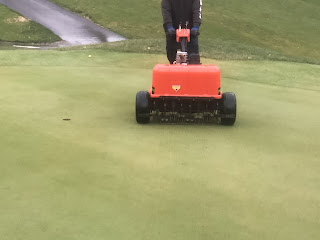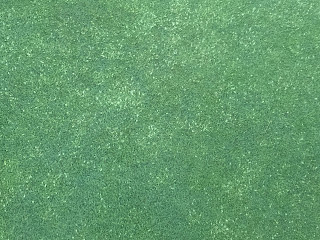Tulips blooming, trees budding out, and the smell of fresh cut grass can only mean one thing at WHCC-golf season has officially started! The grounds department has been busy prepping the golf course for daily play. In addition, the extended work time on Mondays has helped the course significantly. Topdressing, spraying, and some aeration has already begun and, in my opinion, the playability and health of the greens has never been better coming out of the winter season. The proxy applications made in December and February have decreased the amount of noticeable seed heads on the putting surfaces. This has increased green speed and smoothness compared to prior springs. Some of the new and problem greens have been needle tine aerated to help decrease compaction, increase oxygen, and help with drainage. Furthermore, topdressing was initiated in early March and is helping smooth and firm up the putting surfaces for the early golf season. However, on May 1st the putting greens will be deep tine aerated with 1/2" solid tines (weather dependent). This will slow down green speed for around two weeks and make for some bumpy play until the greens heal. This is a necessary practice to keep the greens healthy, fast, and smooth throughout the hot and humid summer months.
 |
| Poa annua seed heads. The right half was sprayed with proxy. Notice the difference in the seed head population between the sprayed side and the non sprayed side. |
 |
| Aerating the new chipping green with needle tines. This machine punctures the soil at a 4" depth. |
 |
| A picture of deep tine aeration done last season. These tines puncture the soil at an 8"+ depth. This helps produce deeper roots. Deeper roots=healthier summer time turf. |
Horticulture
The roller coaster spring temperatures really messed with the bloom time and duration of the tulip flowers. A warm end of February pushed the bulbs out of the ground earlier than usual, leading us to believe that the annual tulip display would be much earlier than expected. Then winter returned in March and froze tulip progression, allowing them to bloom on time for the Easter holiday. Then hot summer temperatures decided to show up and they pushed many of the bulbs to bloom faster than usual. Currently the tulips are past bloom and we will be removing them in the next couple weeks to make room for the summer annuals. We treat the bulbs as annuals and remove them every year. We place them in bags next to the grounds building and they are free for anyone that wishes to pick them up.
The cold winter temperatures negatively impacted many of the less cold tolerant plants on the property. As I have written about in a previous post (click here for the post), late December temperatures dropped to -10 F. This is at the lowest end of the cold spectrum that plants in our area can tolerate. The cold air killed off some azaleas, roses, and defoliated many other shrubs. We are still in the process of discovering what plants survived. Already some of the azaleas behind #3 green have been replaced with 'Karen' azaleas, which are one of the most cold hardy of all the azalea cultivars, to try and keep this from occurring in future winters.
The winter tree removals are completed. Around 20 trees were removed and the stumps ground out. The grindings were removed, filled with soil, and either sodded or seeded. They should grow and fill in the next couple of months.
 |
| Tulips in bloom. |
 |
| White daffodils and grape hyacinth in bloom. |
 |
| The roses by the fountain experienced significant winter desiccation. Luckily we mulch over the crowns in the fall and everything under the mulch survived the winter temperatures. |
 |
| Filling in the stump hole by #13 green. |
Bunkers
In late March the grounds crew measured the sand depth in every bunker and added sand where needed. The 20+ year old bunkers continue to wash out every time there is a thunderstorm that rolls through the tristate. We are experimenting with a newer way to rake the bunkers, called the "Aussie" method, consisting of smoothing out the sides of the bunker and raking the middle. This is supposed to firm up the sides to decrease fried egg lies and allow the golf ball to roll into the center of the bunker. We will continue to test this method and use feedback before making it a permanent practice (click here for more information).
 |
| Aussie method. The sides are smooth raked and the middle hand raked. |
Broadleaf Weeds
As the grass grows so does the springtime weeds. White clover has always been a nuisance on the golf course. It is great for pollinators and produces nitrogen in the soil, but it is very susceptible to compaction and does not make for good golf ball lies. We are using a newer herbicide in our fairway spray applications and spraying the rough to decrease its presence this season. Some other weeds include dandelions, purple deadnettle, chickweed, hairy bittercress, and violet. One of the most invasive spring weeds is lesser celandine. It is a short lived perennial that is on the rise in our area. It is a non native plant brought here from Europe in the 1800s. It blooms in the spring, then dies down to the ground in the summer, and returns the following spring as an expanded colony. It forms a dense mat that chokes out many of our native woodland plants. We are currently making herbicide applications to eliminate this weed and other broadleaf weeds on the golf course.
 |
| Lesser celandine in the woods behind the new north tee. |
 |
| Lesser celandine in the valley between 3 and 4. |
Contractors, Phase 2, and Leaks
Phase 2 of the driving range project is nearing completion. The new north tee has been mowed, aerated, and topdressed and is just about ready to be completely annihilated by practice shots. The new cart path is set to be paved in the next week (along with all of 6 cart path and the cart path from the chipping green to 5 green) and a new safety fence is installed parallel to the cart path to block flying balls originating from the new north tee. The new north tee area is scheduled for opening around Memorial Day.
The in house installation of the concrete barrier bin blocks was completed in January. The unsightliness of their appearance will be blocked by the new green slate chain link fence around the perimeter. This should make the area, that has always been used as a material dumping site, look much more organized with a cleaner appearance.
Irrigation leaks continue to pop up around the grounds. Two tee pipe fittings have been replaced by #10 tee and the new south driving range practice tee. Also, a couple bell-end pipe leaks were replaced. We will continue to fix leaks as they occur.
 |
| Material bin encloser fence. |
 |
| Safety fence by the new north tee cart path |
 |
| Fixing a leaking pipe tee by #10 tee. |
Summer time is just around the corner. In the meantime, the agronomy team will continue to prepare the course for a busy golf season, the grass for the hot and humid summer time conditions, and the clubhouse grounds for all the summer festivities!
Brad Piecuch
Grounds Superintendent

